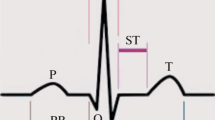Abstract
The purpose of the paper is the evaluation of a radial basis function neural network as a tool for computer aided coronary artery disease diagnosis based on the results of the traditional ECG exercise test. The research was performed using 776 data records from an exercise test (297 records from healthy patients and 479 from ill patients) confirmed by coronary arteriography results. Each record described the state of the patient, provided input data for the neural network, included the level and slope of an ST segment of a 12-lead ECG signal made at rest and after effort, heart rate, blood pressure, load during the test, and occurrence of coronary pain, coronary arteriography, correct output pattern for the neural network, and verified the existence (or not) of more than 50% stenosis of the particular coronary vessels. Radial basis function neural networks for coronary artery disease diagnosis were optimised by choosing the type of radial function, the method of training (setting the number of centres and their dimensions), and regularisation. The best network correctly recognised over 97% of cases from a 400-element test set, diagnosing not only the patients' condition (simple ‘sane-sick’ diagnosis), but also pointing out individual sick/stenosed vessels.
Similar content being viewed by others
References
Dorffner, G., andPorenta, G. (1994): ‘On using feedforward neural networks for clinical diagnosis tasks’,Artif. Intell. Med.,6, pp. 417–435
Edenbrandt, L., Devine, B., andMacfarlane, P. W. (1993): ‘Classification of electrocardiographic ST-T segments—human expert vs artificial neural network’,Eur. Heart J.,14, pp. 464–468
Edenbrandt, L., Devine, B., andMacfarlane, P. W. (1992): ‘Neural networks for classification of ECG ST-T segments’,J. Electrocardiol.,26, pp. 167–173
Fleischmann, K. E., Hunink, M. G., Kuntz, K. M., andDouglas, P. S. (1998): ‘Exercise echocardiography or SPECT imaging? A meta-analysis of diagnostic test performance’,JAMA,280, pp. 913–920
Froelicher, V. (1999): ‘Exercise test manual’ (Bell Corp., Warsaw) (in Polish)
Golub, G. H., Heath, M., andWahba, G. (1979): ‘Generalised cross-validation as a method or choosing a good ridge parameter’,Technometrics,21, pp. 215–223
Hertz, J., Krogh, A., andPalmer, R. G. (1991): ‘Introduction to the theory of neural computation’ (Addison-Wesley)
Lewenstein, K. (1998): ‘Comparison of diagnostic properties of the feedforward and automatically constructed neural network systems’, Computer Simulation in Research and Development, Warsaw, pp. 245–251 (in Polish)
Lewenstein, K., andChojnacki, M. (1995): ‘The possibility of applying the simulated neural network for coronary disease diagnosis’,Pol. J. Med. Phys. Eng.,1, pp. 25–34
Orr, M. J. (1996): ‘Introduction to radial basis function networks’, Centre for Cognitive Science, University of Edinburgh, April
Orr, M. J. (1996): ‘Regularisation in the selection of radial basis function centres’,Neural Comput. 7, pp. 606–623
Ossowski, S. (1996): ‘Neural networks algorithms’, (WNT, Warsaw) (in Polish)
Porenta, G., Dorffner, G., Kundrat, S., Petta, P., Duit-Schedimayer, J., andSochor, H. (1994): ‘Automated interpretation of planar Thalium-201-dipyridamole stress-redistribution scintigrams using artificial neural networks’,J. Nucl. Med.,35, pp. 2041–2047
Tibshirani, R. (1996): ‘A comparison of some error estimates for neural networks model’,Neural Comput.,8, pp. 152–163
Author information
Authors and Affiliations
Corresponding author
Rights and permissions
About this article
Cite this article
Lewenstein, K. Radial basis function neural network approach for the diagnosis of coronary artery disease based on the standard electrocardiogram exercise test. Med. Biol. Eng. Comput. 39, 362–367 (2001). https://doi.org/10.1007/BF02345292
Received:
Accepted:
Issue Date:
DOI: https://doi.org/10.1007/BF02345292




